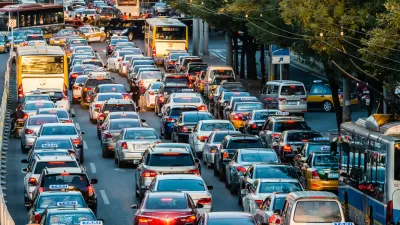The auto industry lobby is meeting with Trump Administration officials to convince them to ease off the throttle.

The auto industry lobby backed candidate Trump in the hopes that he would allow for lax fuel efficiency standard. Now it fears Trump will make those standards so lax it will hurt their profit margins.
California has a higher environmental standard regardless of the federal guidelines, so some in the industry now fear a Trump rollback will split the country into two, costly to serve, markets. "The auto industry, embracing Mr. Trump’s promise of a more industry-friendly administration, has lobbied aggressively for a relaxation of the strict Obama-era rules," Hiroko Tabuchi and Neal E. Boudette report in The New York Times.
For their part, the administration insists the move to allow lower fuel efficiency makes sense and should provide automakers with an opportunity. This leaves the industry and its lobby in an awkward position. "On one hand, they are eager to stay in the good graces of a president who not only is intent on moving forward his deregulatory agenda, but who is also capable, if so inclined, of hurling insults at automakers on Twitter or pushing for damaging tariffs. At the same time, automakers are eager to find a way to work with California, which is intent on sticking with the Obama-era rules and has threatened to sue if the federal government gets in the way," Tabuchis and Boudette explain.
Industry observers point out that if even the automakers are not interested in pushing fuel efficiency standards so low, the intent must be entirely political.
FULL STORY: Automakers Sought Looser Rules. Now They Hope to Stop Trump From Going Too Far

Planetizen Federal Action Tracker
A weekly monitor of how Trump’s orders and actions are impacting planners and planning in America.

Congressman Proposes Bill to Rename DC Metro “Trump Train”
The Make Autorail Great Again Act would withhold federal funding to the system until the Washington Metropolitan Area Transit Authority (WMATA), rebrands as the Washington Metropolitan Authority for Greater Access (WMAGA).

The Simple Legislative Tool Transforming Vacant Downtowns
In California, Michigan and Georgia, an easy win is bringing dollars — and delight — back to city centers.

The States Losing Rural Delivery Rooms at an Alarming Pace
In some states, as few as 9% of rural hospitals still deliver babies. As a result, rising pre-term births, no adequate pre-term care and "harrowing" close calls are a growing reality.

The Small South Asian Republic Going all in on EVs
Thanks to one simple policy change less than five years ago, 65% of new cars in this Himalayan country are now electric.

DC Backpedals on Bike Lane Protection, Swaps Barriers for Paint
Citing aesthetic concerns, the city is removing the concrete barriers and flexposts that once separated Arizona Avenue cyclists from motor vehicles.
Urban Design for Planners 1: Software Tools
This six-course series explores essential urban design concepts using open source software and equips planners with the tools they need to participate fully in the urban design process.
Planning for Universal Design
Learn the tools for implementing Universal Design in planning regulations.
Smith Gee Studio
City of Charlotte
City of Camden Redevelopment Agency
City of Astoria
Transportation Research & Education Center (TREC) at Portland State University
US High Speed Rail Association
City of Camden Redevelopment Agency
Municipality of Princeton (NJ)



























